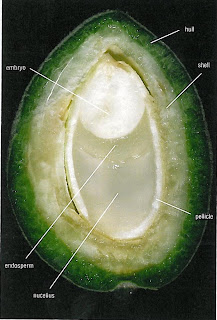April/May/June Almond Nut Development - Rationale for Proper Irrigation and Fertilization
The cool spring has brought up a few questions about almond development that I will do my best to answer today.
Does the cool weather slow nut development?
Yes, it does. By reducing the heating units, almond development is delayed. Similar to peaches, the cooler the weather, the longer it takes to complete the fruit sizing and kernel formation. This usually means that later season events will be delayed - such as hullsplit and harvest.
How can we determine if nut development is complete?

By pulling almonds off of tree and taking cross-sections, it is easy to observe the development of the embryo. As seen in figure 1, the embryo will grow from the tip and eventually fill the entire shell. Preceding embryo development is the endosperm and nucellus which makes up the "jelly" of the almond. The endosperm tends to be a bit more cloudier than the nucellus and proceeds embryo development. Once the embryo is completely developed (i.e. the kernel has filled the shell), weight accumulation will begin in the kernel This generally tends to happen around early June and continue to hullsplit.
Why is knowing when the completion of nut development important?
Most of our UC recommended practices regarding irrigation and fertilization are based around nut development. If you are running short on water due to a curtailment, you might have heard that water can be cut back in Mid-June to help stretch your budget. This point in mid-June refers to when the embryo is completely developed and the dry weight accumulation is nearly done. Cutting water sooner than this will lead to reduction of crop weight, shrivels, and in some cases, nut abortion. In a cooler year, this point may be delayed - so if you are planning on deficit irrigating this summer, make sure your kernel development is complete.
This same principle is also the basis of most fertilizer timing recommendations. Fertilizer should be applied when the tree is growing and kernel is developing, but should cease or be reduced once kernel development is completed. Typically, the last recommended nitrogen application is the first week of June. Nitrogen applied after the kernel is developed will be directed into the hull, not benefiting our harvest yields, and increasing our chance for hull rot. It is important to note that once the nuts are shaken from the tree, nitrogen should be applied to help with shoot and bud formation.
Is nut abortion increased during a cool spring?
Can be. Since the time period to nut maturity is extended, any stress during the various stages of development can lead to nut abortion/crop loss. If the trees are exposed to water stress, excess water, nutrient deficiency, or extremes in temperatures, then nut abortion rates may be higher.
